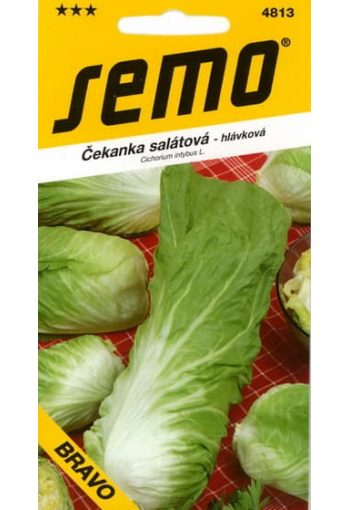Ex Tax: 0.81€
Improves digestion Perennial vegetable plant of the Compositae family, cultivated as a biennial or annual. As a salad, 2 types are grown-endive chicory and witloof chicory. Lettuce leaves are rich in nutrients. They contain ascorbic acid, carotene, mineral salts, proteins, sugars, as well as inulin and intibin, which cause a slight bitterness. Salad chicory has medicinal properties. It contains nitrate, sulfate and hydrochloric acid salts of potassium, which improve the activity of the kidneys. Inulin has a regulating effect on the body's metabolism and is used as a sugar substitute in diabetes. Intibin improves the functioning of the digestive organs and the activity of the liver, gallbladder, pancreas, and cardiovascular system, and has a positive effect on the hematopoietic organs. Chicory endive is grown as an annual crop and used as a salad. The form with a slightly cut leaf blade is known as escariole.
The agrotechnics of cultivation are similar to that of ordinary lettuce. Endive crops are carried out not only in spring but also in summer (in July). Plants in this case can remain in the field until frost and retain nutritional qualities when thawed. You can store rosettes of endive in a closet in the basement, which allows you to extend the use of this valuable product. Unlike endive, witloof chicory is able to form dense cabbages of juicy crispy leaves during forcing in winter, which is used as a salad or stewed. But there are also special varieties of this species - for fresh consumption. These include the Palla Rossa variety. It is sown in open ground in June-July in a sunny place according to the scheme 30 by 30 cm. Seeding rate is 0.4-0.6 g/m2, sowing depth is 1-1.5 cm.
Normal care: weeding, loosening row spacing. Harvest before a frost. Heads of dense beet colour with clear veins. The taste is pleasant with a slight bitterness. It has a high content of vitamins and biologically active substances.
Eng.: Witloof Chicory. Suom.: Salaattisikuri. Sven.: Sockertoppsallat. Bot.: Cichorium intybus var. sativum.
Magnificent witloof.
In 1879, an unknown vegetable appeared on the Parisian market - witloof (translated from Flemish - white leaf). He was a great success with gourmets, who immediately proclaimed him the new vegetable king to replace the asparagus that had managed to bother everyone. It was presented to the public by the chief gardener of the Brussels Botanical Garden, Mr Brezier. He kept the secret of the origin of the new culture until the end of his days. And only after his death, it was possible to find out that the magnificent witloof is ordinary chicory, only grown in a special way: in the dark and with virtually no soil. This explains the characteristic pale colour of its leaves.
In fact, witloof, or salad chicory, are basal shoots that sprout from any root crop. Brezier's merit is that from these sprouts he managed to get a new vegetable rich in vitamins and minerals. Dense, oblong sprouts with an original, slightly bitter taste can be grown all year round.
It is better to buy completely white or with leaves that have turned yellow at the tips - they have less bitterness. However, there are lovers who claim that it is the bitterness that gives salad chicory a special piquancy and stimulates the appetite. If this piquancy is not to your liking, be sure to cut out the cone-shaped base of the cabbage head before use. Excess bitterness can also be removed by lowering the chicory for a minute in boiling water. And you need to store it in the dark (preferably wrapped in paper), otherwise, it will become bitter.
From simple to complex.
Chicory is used in any form. It is often eaten raw. The head of cabbage is disassembled into leaves, which are washed and laid out on a plate - without any dressing. Chicory leaves can themselves become a "plate" that can be filled with anything: chopped egg, minced meat, pate ...
It is also good to cut cabbage into circles and season with mayonnaise, sour cream or bechamel sauce. You can serve them with blue cheeses, baked fish, oysters or fruits - especially citrus fruits. Try making salads with chicory. Mix it with apples and hazelnuts, thin green beans, walnuts and grapes, or beetroot seasoned with balsamic vinegar. In Belgium, they make a salad with yoghurt and carrots, in Italy - with dandelions and mustard dressing, in France - with garlic, ham and croutons.
In Europe, chicory is traditionally served as a side dish. To do this, it is boiled for 15 minutes in boiling salted water and eaten with butter, as well as stewed and seasoned with sour cream sauce, fried and served with meat and fish dishes. Chicory boiled until half cooked is baked in the oven with apples, cheese or ham. It makes a particularly tender, thick soup - velouté.
BY THE WAY:
In Europe, chicory began to be cultivated in the 18th century: the roasted and ground roots of the plant were added to coffee, an expensive colonial commodity.
Unlike natural coffee, chicory does not contain potent substances and does not have a stimulating effect on the nervous and cardiovascular systems. Therefore, it is especially appreciated by those to whom coffee is contraindicated. Chicory contains the special substance inulin, which replaces sugar for diabetics. In folk medicine, it is used as an antimicrobial and anti-inflammatory agent.
Chicory contains many vitamins and minerals, while 100 g contains only 15 kcal.











